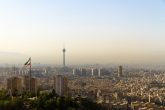May 24, 2018
The One Place in Syria That Works
Why southwest Syria is an island of stability.
The last few months in Syria have been the latest in a string of awful months. After an estimated 511,000 deaths since the war began in 2011, the Bashar al-Assad regime has recently gotten the upper hand and is applying maximum pressure on opposition-held areas across the country. Civilians have been under attack, including with chemical weapons, and humanitarian aid routes have been cut off. Growing outside involvement — from Russia, Turkey, Israel, and the United States, among many others — suggests the conflict will, if anything, grow larger and worse.
Yet there is one pocket in Syria that has remained comparatively calm, despite the surrounding turbulence. Southwest Syria — in particular Quneitra province on the Syrian side of the Golan Heights, and the areas close to it in the northwest part of Daraa province — has seen significantly less fighting than other regions. The moderate opposition has been stronger here in Quneitra and its surrounding areas, extremist groups although present do not have the upper hand, and the humanitarian conditions are considerably better than in most other regions of Syria. This region is also strategically important, as it is where Israel and Iran are engaged in a competition for control over the Syrian side of the Golan Heights, which is a pivotal site for both sides to have mastery over in the event of a wider conflict between them.
Given the stakes involved in ensuring that Quneitra and its surrounding area in Daraa stay outside the control of Iran, and the rarity of its existing success for moderate opposition governance in Syria, this region deserves study to see what lessons can be learned from it.
There are a few potential factors that make this region of Syria unique. There is the relative proximity to Israel, which makes the Assad regime more cautious in intervening. Jordan, the United States, and Russia have also succeeded in establishing a de-escalation zone in the region last July. Quneitra and its surrounding area in Daraa is also one of the few places in Syria where the moderate armed opposition forces still receive outside support, particularly with salaries and periodic shipments of ammunition, which provide an additional layer of security against extremist actors trying to seize power.
Read the Full Article at Foreign Policy
More from CNAS
-
“The Ayatollah Has No Clothes” – with Rich Goldberg and Richard Fontaine
Richard Fontaine is CEO of the Center for American Security, joins Call Me Back to assess the threat FROM Iran and the threat TO Iran. Listen to the full episode on Call Me ...
By Richard Fontaine
-
What Does Yahya Sinwar’s Death Mean for the War in Gaza?
Jonathan Lord, Senior Fellow and Director of the Middle East Security program, joins RN Drive to discuss the death of Sinwar who has long been viewed as one of the militant gr...
By Jonathan Lord
-
Russia in the Middle East with Jonathan Lord and Hanna Notte
One year after the October 7 attacks by Hamas, the crisis in the Middle East has grown more and more complex. With the region teetering on the brink of broader conflict, the B...
By Jonathan Lord, Hanna Notte, Andrea Kendall-Taylor & Jim Townsend
-
A Year of Anguish for the Hostages in Gaza—and Their Families
October 7 gave rise to unexpected bipartisan coalitions of D.C. experts and legislators who lent their knowledge to help U.S. hostage families and victims of the conflict navi...
By Daniel Silverberg




